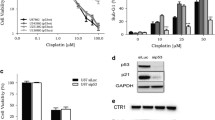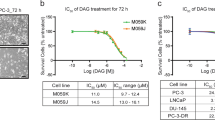Summary
Camptothecin-11 (CPT-11) is a new derivative of camptothecin, a plant alkaloid antitumor agent. Previous studies indicated that antitumor activity of CPT-11 was mediated through interaction of the drug with its target enzyme, DNA topoisomerase I (topo I).
To elucidate the mechanisms of CPT-11 resistance, we have characterized glioma cell lines (T98G/CPT-11, C6/CPT-11) selected from the wild types (T98G. C6) for acquired resistance to CPT-11. T98G/CPT-11 and C6/CPT-11 cells demonstrated 5.4- and 7.3-fold increases, respectively, in resistance to CPT-11.
Total glutathione S-transferase (GST) and GST-p activities were similar in CPT-11-sensitive and -resistant cells. No difference in intracellular accumulation of CPT-11 was observed between CPT-11-resistant and parental cells, indicating that an alteration in the uptake was not responsible for resistance. In addition, CPT-11-resistant cell lines showed no change in the total activity of Topo I, indicating an alteration in total Topo I activity was not responsible for resistance.
In contrast, significantly increased intracellular glutathione (GSH) levels were found in T98G/CPT-11 and C6/CPT-11 cells (4.3- and 2.1-fold). Furthermore, Topo I samples from T98G/CPT-11 and C6/CPT-11 cells were at least 4- and 2-fold more resistant to the inhibitory effect of the CPT-11 on the relaxation activity of Topo I than were Topo I samples from their respective parent lines. The resistance of the enzyme itself to the effects of CPT-11 may be responsible for the resistance to CPT-11. Thus, at least two distinct mechanisms have been selected for the CPT-11-resistant cells.
Similar content being viewed by others
References
Gallo RC, Whang-Peng J, Adamson RH: Studies on the antitumor activity, mechanism of action, and cell cycle effects of camptothecin. J Natl Cancer Inst 46: 789–795, 1971
Gottlieb JA, Luce KJ: Treatment of malignant melanoma with camptothecin (NSC100880). Cancer Chemother Rep 56: 103–105, 1972
Moertel CG, Schutt AJ, Reitemeier RJ, Hahn RG: Phase II study of camptothecin (NSC-100880) in the treatment of the advanced gastrointestinal cancer. Cancer Chemother Rep 56: 95–101, 1972
Muggia FM, Creaven PJ, Hansen HH, Cohen MH, Selawry OS: Phase I clinical trial of weekly and daily treatment with camptothecin (NSC100880): correlation with preclinical studies. Cancer Chemother Rep 56: 515–521, 1972
Matsuzaki T, Yokokura T, Mutai M, Turuo T: Inhibition of spontaneous and experimental metastasis by a new derivative of camptothecin, CPT-11, in mice. Cancer Chemother Pharmacol 21: 308–312, 1988
Andoh I, Ishii K, Suzuki Y, Kusunoki Y, Takemoto Y, Okada K: Characterization of a mammalian mutant with a camptothecin-resistant DNA topoisomerase I. Proc Natl Acad Sci USA 84: 5565–5569, 1987
Okamoto H, Saijo S: Preclinical trial from the standpoint of clinical trials. Jpn J Cancer Chemother 18: 1467–1475, 1991
Fukuoka M: A phase II study of CPT-11, a camptothecin derivative, in patients with primary lung cancer. Jpn J Cancer Chemother 18: 1013–1019, 1991
Niitani H: An early phase II study of CPT-11 for primary lung cancer. Jpn J Cancer Chemother 18: 607–612, 1991
Taguchi T: DNA topoisomerase inhibitor as chemother-apeutic drug — Clinical point of view. Jpn J Cancer Chemother 18: 1574–1578, 1991
Takeuchi S: An early phase II study of CPT-11 for gynocologic cancers. Jpn J Cancer Chemother 18: 579–584, 1991
Habig WH, Pabst MJ, Jakoby WB: Glutathione S-transferases. J Biol Chem 249: 7130–7139, 1974
Bradford MM: A rapid and sensitive method for the quantitation of micrgram quantities of protein utilizing the principle of protein-dye binding. Anal Biochem 72: 248–254, 1976
Hissin PJ, Hilf R: A fluorometric method for determination of oxidized and reduced glutathione in tissues. Anal Biochem 74: 214–226, 1976
Chow KC, Johnson TL, Pearson GD: A novel method for the detection and quantitation of eukaryotic topoisomerase I. Biotechniques 3: 290–296, 1985
Takano H, Kohno K, Ono M, Ushida Y, Kuwano M: Increased phosphorylation of DNA topoisomerase II in etoposide-resistant mutants of human cancer KB cells. Cancer Res 51: 3951–3957, 1991
Hsing YH, Liu LF: Identification of mammalian DNA topoisomerase I as an intracellular targets of the anti cancer drug camptothecin. Cancer Res 48: 1722–1726, 1988
Liu LF, Miller KG: Eukarytic DNA topoisomerase: two forms of type I DNA topoisomerases from HeLa cell nuclei. Proc Natl Acad Sci USA 78: 3487–3491, 1981
Matsumoto Y, Sasaoka N, Tsuchida T, Fujiwara T, Nagao S, Ohmoto T: Fluorescent dye rhodamine 6G as a molecular probe to study drug resistance of C6 rat glioma cells. J Neurooncol 13: 217–222, 1992
Matsumoto Y, Sasaoka N, Tsuchida T, Fujiwara T, Nagao S: Quantitative analysis of glutathione S-transferase in human brain tumors, C6 rat glioma cells, and drug resistant C6 cells. In: Tabuchi (ed) Biological aspects of brain tumors. Tokyo: Springer-Verlag, 1991, pp 281–287
Andoh T, Okada K, Oguro M: Biological function of DNA topoisomerases and its implication in cancer chemotherapy. Jpn J Cancer Chemother 15: 1–14, 1988
Chen GL, Lie LF: DNA topoisomerases as therapeutic targets in cancer chemotherapy. Annu Rep Med Chem 21: 257–262, 1986
Lie LF, Lie CC, Albert BM: Type II DNA topoisomerases: enzymes that can unknot a topologically knotted DNA molecule via a reversible double-strand break. Cell 19: 697–707, 1980
Wang JC: DNA topoisomerases. Annu Rev Biochem 54: 665–697, 1985
Wang JC: Recent studies of DNA topoisomerases. Biochem Biophys Acta 909: 1–9, 1987
Tewey KM, Chen GL, Nelson EM, Lie LF: Intercalative antitumor drugs interfere with the breakage-reunion reaction of mammalian DNA topoisomerase II. J Biol Chem 259: 9182–9187, 1984
Ross WE: DNA topoisomerases as targets for cancer therapy. Biochem Pharmacol 34: 4191–4195, 1985
Drlica K, Franco RJ: Inhibitors of DNA topoisomerases. Biochemistry. 27: 2253–2259, 1988
Kawato Y, Aonuma M, Hirota Y, Kuga H, Sato K: Intercellular role of SN-38, a metabolite of the Camptothecin derivative CPT-11, in the antitumor effect of CPT-11. Cancer Res 51: 4187–4191, 1991
Fujiwara Y, Sugimoto Y, Kasahara K, Bungo M, Yamakido M, Kenneth DT, Saijo N: Determinants of drug response in a cisplatin-resistant human lung cancer cell line. Jpn J Cancer Res 81: 527–535, 1990
Buller AL, Claper ML, Tew KD: Glutathione S-transferases in nitrogen mustard-resistant and -sensitive cell lines. Mol Pharmacol 31: 575–578, 1987
Smith MT, Evans CG, Doane SP, Castro VM, Tahir MK, Mannervik B: Denitrosation of 1.3-bis(2-chloroethyl)-1-nitrosourea by class mu glutathione transferase and its role in cellular resistance in rat brain tumor cells. Cancer Res 49: 2621–2625, 1989
Ochi T, Otsuka F, Takahashi K, Ohsawa M: Glutathione and metallothionein as cellular defense against cadmium toxicity in cultured Chinese hamster cells. Chem Biol Interact 65: 1–14, 1988
Eng WK, Mccabe FL, Tan KB, Mattern MR, Hofmann GA, Woessner RD, Hertzberg RP, Johnson RK: Development of a stable camptothecin-resistant subline of P388 leukemia with reduced topoisomerase I content. Molec Pharmacol 38: 471–480, 1991
Kanzawa F, Sugimoto Y, Minato K, Kasahara K, Bungo M, Nakagawa K, Fujiwara Y, Lie LY, Saijo N: Establishment of a camptothecin analogue (CPT-11)-resistant cell line of human non-small cell lung cancer: Characterization and mechanism of resistance 50: 5919–5929, 1990
Towatari M, Uto Y, Morishita Y, Tanimoto M, Kawashima K, Morishita Y, Ando K, Saitoh H: Enhanced expression of DNA topoisomerase II by recombinat human granulocyte colony-stimulating factor in human leukemia cells. Cancer Res 50: 7198–7202, 1990
Sugimoto Y, Tsukahara S, Ohhara T, Liu LF, Turuo T: Elevated expression of DNA topoisomerase II in camptothecin-resistant human tumor cell lines. Cancer Res 50: 7962–7965, 1990
Turuo T, Matsuzaki T, Matsushita M, Saitoh H, Yokokura H: Antitumor effect of CPT-11, a new derivative of camptothecin, against pleiotropic drug-resistant tumorsin vitro andin vivo. Cancer Chemother Pharmacol 21: 71–74, 1988
Author information
Authors and Affiliations
Rights and permissions
About this article
Cite this article
Matsumoto, Y., Fujiwara, T. & Nagao, S. Determinants of drug response in camptothecin-11-resistant glioma cell lines. J Neuro-Oncol 23, 1–8 (1995). https://doi.org/10.1007/BF01058453
Issue Date:
DOI: https://doi.org/10.1007/BF01058453




